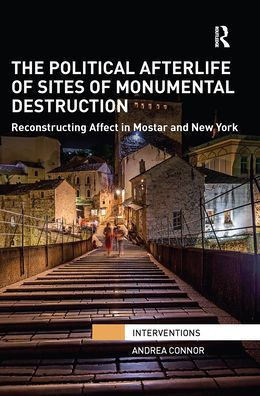In 1993, during the Bosnian war, the Mostar Bridge was completely destroyed. Reconstructed in 2004, as an exact copy of the original, this "new Old Bridge" has assumed an afterlife as an intentional monument to reconciliation. The World Trade Centre, in New York, has also been transformed since its destruction in 2001, as a place of national mourning and remembrance, a symbolic void marking a singular act of terrorism. Using recent work on affect and object agency Connor considers their contested reconfiguration as sites of collective remembering and forgetting in new highly charged political contexts. She argues for a more expansive notion of reconstruction – encompassing not only the material and symbolic afterlife of both things but also their affecting afterlives as they are re-assembled in the present.
Provoking a reconsideration of the way monuments and heritage sites, even in their absence, become powerful agents of historical narrativization, this work will be of interest to students and scholars in a range of fields including international relations, cultural studies, critical heritage studies, and material culture studies.
In 1993, during the Bosnian war, the Mostar Bridge was completely destroyed. Reconstructed in 2004, as an exact copy of the original, this "new Old Bridge" has assumed an afterlife as an intentional monument to reconciliation. The World Trade Centre, in New York, has also been transformed since its destruction in 2001, as a place of national mourning and remembrance, a symbolic void marking a singular act of terrorism. Using recent work on affect and object agency Connor considers their contested reconfiguration as sites of collective remembering and forgetting in new highly charged political contexts. She argues for a more expansive notion of reconstruction – encompassing not only the material and symbolic afterlife of both things but also their affecting afterlives as they are re-assembled in the present.
Provoking a reconsideration of the way monuments and heritage sites, even in their absence, become powerful agents of historical narrativization, this work will be of interest to students and scholars in a range of fields including international relations, cultural studies, critical heritage studies, and material culture studies.

The Political Afterlife of Sites of Monumental Destruction: Reconstructing Affect in Mostar and New York
216
The Political Afterlife of Sites of Monumental Destruction: Reconstructing Affect in Mostar and New York
216
Product Details
| ISBN-13: | 9781032242194 |
|---|---|
| Publisher: | Taylor & Francis |
| Publication date: | 12/13/2021 |
| Series: | Interventions |
| Pages: | 216 |
| Product dimensions: | 6.12(w) x 9.19(h) x (d) |
